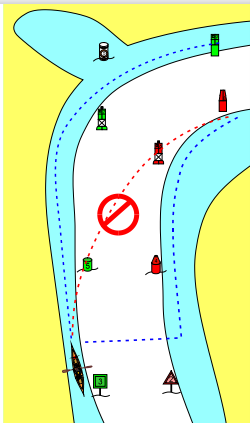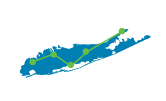Kayaking 101 - 9 Easy Steps
1. Rules of the Road for Paddlers
A) Boat channels are designated as Red and Green buoys. Stay clear of boat channels where there is likely to be boat traffic. Buoys mark the road for boaters, paddle on the sidewalk.
B) When crossing a boat channel, cross quickly perpendicular to the channel at the narrowest point.

C) Paddle close to shore in shallow water to avoid boat traffic
D) Technically human powered craft have the right of way however DO NOT TEST THIS. Ultimately mass tonnage and speed will win every time.
E) Kayaks are often more maneuverable than large vessels and it is the responsibility of paddlers to get out of the way.
F) Be wary of vessels that have limited control, such as sailboats under sail.
G) Watch for water skiers and tubers they are watching behind them, not where they are going. Jet skiers perform unexpected maneuvers, keep a watchful eye.
H) Assume a boater does not see you.When the sun is behind you the boats coming at you are blinded by the sun.
I) Use a white light that is visible 360 degrees in low light.
J) Wear bright colors for increased visibility
K) Do not paddle alone
2. Recommended / Required Equipment
A) Personal Flotation Device (PFD) a.k.a. Life jacket – Required to be worn
B) An inflatable one can be more comfortable if you prefer.
C) Audible signaling device (whistle, horn etc.) – Required
D) Visual signaling device (flashlight, signal mirror, hand-held flare) – Recommended
E) Bilge Pump – Recommended
F) Paddle Float – Recommended Tide
G) Decked (i.e. sit-in) kayaks should have internal bulkheads or float bags
H) Spare paddle – Recommended
I) Cell phone in a waterproof bag.
J) First aid kit
Additional Items -
K) Sunscreen
L) Hat
M) Water
N) Food
O) Personal Medication (i.e. inhaler, epipen etc.)
3. What to know before you go
- Air Temperature
- Water Temperature – Cold water is very unsafe. During much of the year the water can be cold, a dry suit or wet suit is a must in water as warm as 50 – 60 degrees, which can result in hypothermia or “Cold Water Shock”. Check water temperatures online at CWTG – NCEI Coastal Water Temperature Guide – Atlantic Coast: North (noaa.gov). Always dress for the water temperature, not the air temperature.
- Wind Speed and Direction.
- Probably of Rain/Thunderstorms
-
-
-
B) Currents – Bridge crossing and inlets produce the most challenging conditions characterized by faster moving currents, eddies and variable water conditions dependent upon tidal flow. Such currents are caused by ebb (outgoing) and flood (incoming) tidal flows. Due to these factors trail users navigating between bays at bridge abutments and across inlets need to be at an advanced skill level.
C) Anticipated Hazards (i.e. Boat Traffic, Strong Currents, Obstacles etc.)
D) Tides – The changing tides alter the currents in the bays. Plan to travel with the tidal current, when the tidal current turns paddle with it in the return direction. There are a number of tidal flats, passageways between marsh islands, and creeks that become completely mud during lower tides. Paddlers can become stranded, stuck in the mudflats at low water and must wait for the tide to turn. Tide charts are available at most park offices. Check tide charts as part of trip planning, online at http://www.lishore.org or NOAA Tidal Forecast
E) Trip Paddle level (i.e. beginner, intermediate, expert) & Skill level of paddlers (i.e. beginner, intermediate, expert)
The Long Island Paddlers have devised trip ratings for conditions and skills, as well as endurance ratings, which is recommended as a guide when planning a trip on the blueway.
4. Leave No Trace
A) Plan Ahead and Prepare
B) Dispose of Waste Properly
C) Minimize Campfire Impacts
D) Be Considerate of Other Visitors
E) Travel and Camp on Durable Surfaces
F) Leave What You Find
G) Respect the Wildlife
5. Paddling Edicate and Courtesy
A) When using docks or ramps, set-up and break down gear out of the way of boat traffic. Keep time at the ramp or dock as short as possible.
B) Avoid areas where there are swimmers.
C) Respect private property (do not trespass)
D) If you must use long parking spaces meant for trailers, consider doubling up, putting 2 cars in each spot.
E) Yield to boat traffic
6. File a Float Plan
7. Water Quality
Water quality issues, effluent, and high bacteria counts can make water contact unsafe. The Nassau County Department of Health conducts routine monitoring at beaches and provides a message of beach closings and sewage spills on its helpline (516) 227-9700 or sign up for email notice of sewage leaks from United Water at https://apps.nassaucountyny.gov/DPW/maillinglist.php .
8. South Shore Blueway Site Specific Information (both in-season and out of season)
9. Paddling Resources
Additional resources for you to get involved in the paddling community, could be a great benefit to those who are new to paddling or looking for some company out on the water.
A) Learn to properly handle your boat in local water conditions. Know how to self-rescue.
B) Join a local paddling club or meetup for group excursions and skills clinics.
C) Learn waterway names
D) Take lessons from a qualified outfitter – Empire Kayaks quick start and rescue clinics.
E) Rentals


